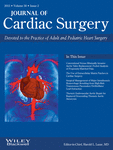Resection of Calcified Aortic Heart Leaflets In Vitro by Q-Switched 2 µm Microsecond Laser Radiation
ABSTRACT
Background
Transcatheter aortic valve implantation (TAVI) can result in paravalvular leakage and stent deformation in the presence of severe calcification. This study was undertaken to determine the efficacy of laser-assisted resection of calcific aortic valve leaflets as a method to minimize the effects of calcium on perivalvular leakage during TAVI.
Methods
A Q-switched Tm:YAG laser emitting at a wavelength of 2.01 μm was used to evaluate the cutting efficiency on highly calcified human aortic leaflets in vitro (N = 10). A pulse energy of 4.3 mJ, a pulse duration of 0.8–1 μs, and a repetition rate of 1 kHz were used. The radiation was transmitted via a 200 µm core diameter quartz fiber. Resection was performed in a fiber-tissue contact mode on water-covered samples in a dish. The remnant particles were analyzed with respect to quantity and size by light microscopy.
Results
A resection rate of 40.4 ± 22.2 mg/min on highly calcified aortic leaflets was achieved. This corresponds to a cutting speed of approximately 1 cm/min; a laser dissection time of 3 min per leaflet is expected. The majority of the remnant particles (85.4%) were <6 μm in diameter, with only 0.1% exceeding 300 μm.
Conclusions
The Q-switched Tm:YAG laser system showed promising results in cutting calcified aortic valves, by transmitting sufficient energy through a small flexible fiber. Catheter-based removal of aortic valve calcification may help to improve TAVI technology. doi: 10.1111/jocs.12481 (J Card Surg 2015;30:157–162)




